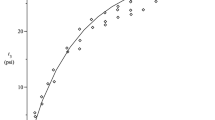Abstract
If a solid body is deformed along one direction, by a uniaxial applied stress for instance, then strains will also be induced in perpendicular directions. The negative ratio of the induced strain to the applied strain is known as the Poisson ratio. Analysis of the elasticity tensor relating stress and strain within a solid shows that if the induced strain is restricted, then a greater stress is required to produce the same strain; it appears stiffer. Many biological materials with a mechanical function are subject to forces which are primarily uniaxial. This mechanism appears to be used to maximize the uniaxial load-bearing properties of some of these materials. Muscles are commonly surrounded by strong sheets of connective tissue which will constrain the lateral expansion of the muscle as it contracts. This increases the stress in the muscle for a given strain, and hence the load it can support. Similarly, cancellous bone is normally surrounded by a shell of much stronger compact bone and this effectively increases the stiffness of the cancellous bone without the penalty of increasing the mass, as would be the case if the same stiffening was produced by increasing the degree of calcification. It also has important implications for the failure of bone, which is largely a function of strain rather than stress.
Similar content being viewed by others
References
G. JERONIMIDIS and J. F. V. VINCENT, in “Connective Tissue Matrix”, edited by D. W. L. Hukins (Macmillan, London, 1984) p. 187.
T. K. BORG and J. B. CAULFIELD,Tissue Cell 12 (1980) 197.
R. W. D. ROWE, ibid.13 (1981) 681.
R. WARWICK and P. L. WILLIAMS, in “Gray's Anatomy”, 35th Edn (Longman, Edinburgh, 1973) p. 490.
R. W. RAMSEY and S. F. STREET,J. Cell. Comp. Physiol. 15 (1940) 11.
S. WINEGRAD and T. F. ROBINSON,Eur. J. Cardiol. 7 (1978) 63.
E. B. KAPLAN,J. Bone Joint Surg. A40 (1958) 817.
J. E. MACINTOSH, N. BOGDUK and S. GRACOVETSKY,Clin. Biomech. 2 (1987) 78.
F. LINDE and I. HVID,J. Biomech. 22 (1989) 485.
J. F. NYE, in “Physical Properties of Crystals”, 2nd Edn (Clarendon Press, Oxford, 1985) p. 131.
L. N. G. FILON,Phil. Trans. R. Soc. A198 (1902) 147.
D. W. L. HUKINS, in “Collagen in Health and Disease”, edited by M. I. V. Jayson and J. B. Weiss (Churchill-Livingstone, London, 1982) p. 49.
R. M. ASPDEN,Proc. R. Soc. A406 (1986) 287.
T. A. SIKORYN and D. W. L. HUKINS,J. Mater. Sci. Lett. 7 (1988) 1345.
W. G. HORTON,J. Bone Joint Surg. B40 (1958) 552.
D. S. HICKEY and D. W. L. HUKINS,Spine 5 (1980) 106.
R. B. CLARK and J. B. COWEY,J. Exp. Biol. 35 (1958) 731.
P. PURSLOW,J. Biomech. 22 (1989) 21.
G. F. ELLIOTT, J. LOWY, and C. R. WORTHINGTON,J. Mol. Biol. 6 (1963) 295.
A. HIGDONet al., “Mechanics of Materials’, 3rd Edn (Wiley, New York, 1976) p. 157.
D. W. L. HUKINS, R. M. ASPDEN and D. S. HICKEY,Clin. Biomech. 5 (1990) 30.
D. W. L. HUKINS, R. M. ASPDEN and Y. E. YARKER,Eng. Med. 13 (1984) 153.
R. M. ASPDEN and D. W. L. HUKINS,Matrix 9 (1989) 486.
D. CARRet al., Spine 10 (1985) 816.
C. L. PROSSER, in “Comparative Animal Physiology”, 3rd Edn (Saunders, Philadelphia, 1973).
T. C. RUCH and J. F. FULTON, in “Medical Physiology and Biophysics”, 18th Edn of Howells Textbook of Physiology (Saunders, Philadelphia, 1960) p. 107.
R. M. ASPDEN,Spine submitted.
M. IKAI and T. FUKUNAGA,Int. Z. Angew. Physiol. 26 (1968) 26.
S. T. TAKASHIMAet al., J. Biomech. 12 (1979) 929.
T. D. WIESLOW and A. WIGREN,Acta Orthop. Scand. 45 (1974) 599.
D. R. CARTERet al., ibid.52 (1981) 481.
Idem,,J. Biomech. 14 (1981) 461.
K. SHORT, in “Material Properties and Stress Analysis in Biomechanics”, edited by A. L. Yettram (Manchester University Press, Manchester, 1989) p. 95.
Author information
Authors and Affiliations
Rights and permissions
About this article
Cite this article
Aspden, R.M. Constraining the lateral dimensions of uniaxially loaded materials increases the calculated strength and stiffness: application to muscle and bone. J Mater Sci: Mater Med 1, 100–104 (1990). https://doi.org/10.1007/BF00839075
Received:
Accepted:
Issue Date:
DOI: https://doi.org/10.1007/BF00839075




